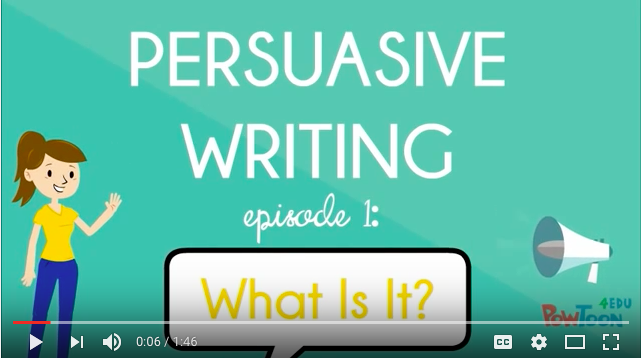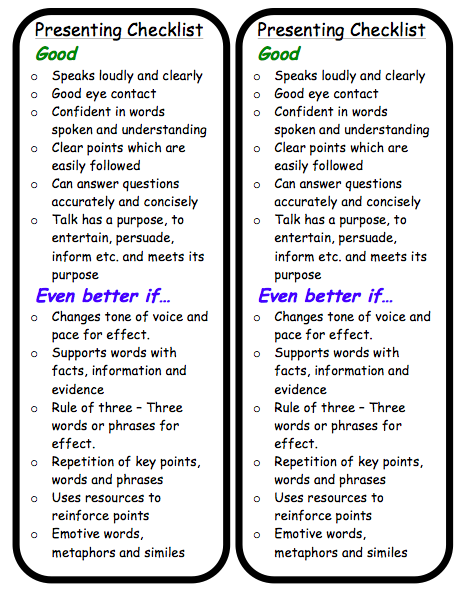Persuasive Writing
What is Persuasive Writing?
This is a wonderful resource to introduce your class to persuasive writing. The tutorial highlights the main features of persuasive writing and the different types used in the world around us.
Speaking and Listening Checklist
We all know that children should be given ownership of their learning. We give them checklists for writing and day to day activities, so why not give your children a checklist for Speaking and Presenting?
Download our Speaking and Presenting checklist to help your children develop their skills.
The Rule of Three
Everything sounds right when it comes in threes. If you want to deliver a persuasive argument and encourage people to buy into what you are saying, download our Rule of Three Activity and examples sheet.
Your children will look at a range of quotes and phrases and alternate their tone to reach their targeted audience.
Rule of Three - Activity Sheet
Challenge your children to research to find examples of the Rule of Three.
Download our activity sheet to see the different areas to look.
Rule of Three - Company Slogan Examples
In this resource we have highlighted 14 company slogans that have used the Rule of Three to advertising purposes.
Click the image to download.
Repetition and Breathless Sentences
Repetition and breathless sentences are used as tools to deliver impact in speeches and presentations. Repetitive language reiterates the main points and drills home the core message. It gives the spoken words importance, significance and power.
Check out our Activity and Examples pages to help your children develop this speaking and presenting tool.
Persuasive Writing
Trying to persuade others is an art. To master the technique you need to learn a variety of tips.
You don’t need to show both sides of the argument, you present your ideas and viewpoint on a topic. For instance, say you had to persuade a group of people to buy a particular car. You could mention the beautiful looks, performance, interior and the low price for such a fantastic car.
The details you choose to write about are important, as you want the people to purchase your car. You must convince the group of people using persuasive language and words. Sales people persuade for their bread and butter.
One thing you wouldn’t write about is your competitors. Avoid even putting other cars into the question. Putting down other brands won’t make yours sound better. You don’t persuade like this. You must focus on your product/brand alone. Below are a few key tips to remember when writing to persuade.
Be confident and passionate – If you are writing about how great your brand of cupcakes are, keep repeating the idea. Convince yourself how good the cupcakes are – they might even be a healthy alternative to conventional cakes, and because this cupcake is backed by many health specialists it makes it much more unique and special. Once you have convinced yourself, it’s much easier to convince others. So next you need to remember to…
Keep the focus on Positivity – When we venture into a car showroom and we are approached by a salesperson, we all know we are going to get a persuasive sales pitch. It’s important to understand that these pitches vary. An ineffective sales pitch will focus on other makes and models and run them into the ground. An effective sales pitch will keep the focus and attention on their cars and brand. After all, the costumer has visited this showroom to find out about your cars – not your competitors.
Remember: It’s always better to hear how good your idea is rather than how bad other people’s are. So write about the things that show your ideas in the best light.
Be pushy – If you appear unsure to your audience, or if you can’t make your fundamental ideas stand out, then you aren’t really persuading as much as you ought to be. Below is The Persuaders’ Toolkit; it explains a variety of strategies to improve your persuasive game. Now, you may not want to be a sales person but many of the skills can be used in different situations.
The Persuader’s Toolkit
Repeat yourself – don’t worry about saying the same thing again and again – people forget. Repeating yourself and constantly reinforcing your ideas will drill in into your audience and help them remember the key points. Even when you think your audience might remember, you can always repeat yourself another time. Ensure you don’t make the repetition your only persuasive tool other things must be included. Keep reading…
Be personal – using words such as “we” or “I” always sounds a lot more convincing. We all know that, don’t we?
Use questions – why would you use questions when writing to persuade? Well, questions provoke thought and encourage people to ponder what you are writing. They also get your readers involved in what you are writing and they will begin to take a viewpoint on the subject you’re writing about.
Use feelings to push ideas – Feelings and emotions are built into us all and appealing to these can boost chances of persuading others. Persuasive words are fantastic ammunition. In seconds, they can make your friends laugh, or your teacher angry, so why not use them properly to persuade your readers? For instance, don’t just write “the pressure of doing school work”, because there is no real feeling there. Instead, how about: “the endless trauma, the desperation and the mindless suffering that school work inflicts on students”.
To find out more about teaching persuasive writing or other areas of english visit:








